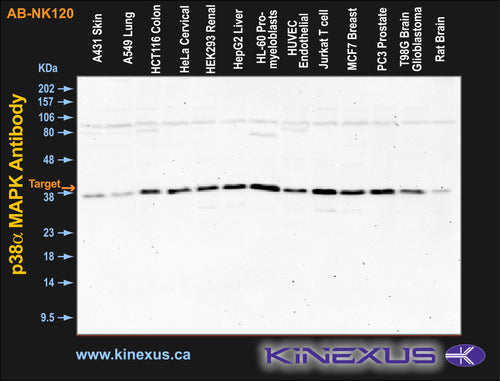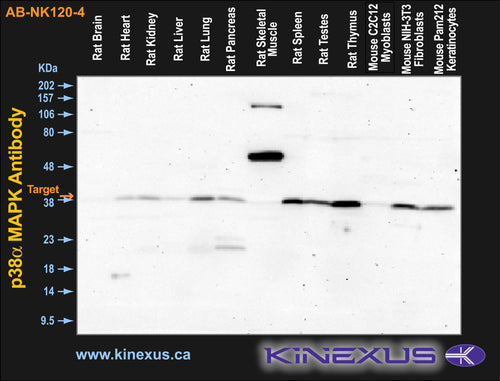Product Name:
p38
Product Number:
ab-nk120-4
Target Full Name: Mitogen-activated protein kinase 14
Target Alias: CSAID Binding protein 1; CSBP1; CSBP2; EXIP; MAP kinase MXI2; MAPkinase p38alpha; MAPK14; p38 ALPHA; p38 MAP kinase; p38 mitogen activated protein kinase; RK; SAPK 2A; Stress activated protein kinase 2A
Product Type Specific: Protein kinase pan-specific antibody
Antibody Code: NK120-5
Antibody Target Type: Pan-specific
Protein UniProt: Q16539
Protein SigNET: Q16539
Antibody Type: Polyclonal
Antibody Host Species: Rabbit
Antibody Immunogen Source: A 20 residue synthetic peptide based on the human p38 with the cysteine residue added and coupled to KLH.
Antibody Modification: Protein kinase pan-specific antibody
Antibody Concentration: N/A mg/ml
Storage Buffer: Rabbit antiserum
Storage Conditions: For long term storage, keep frozen at -40°C or lower. Stock solution can be kept at +4°C for more than 3 months. Avoid repeated freeze-thaw cycles.
Product Use: Western blotting, Immunoprecipitation, Immunohistochemistry
Antibody Dilution Recommended: 1:5000 (ECL) (WB), 1:250 (IP)
Antibody Potency: Very high potency. Detects a ~43 kDa protein corresponding to the molecular mass of p38 on SDS-PAGE immunoblots.
Antibody Species Reactivity: Human, Monkey, Mouse, Rat, Bovine, Rabbit, Pig, Canine, Hamster, Chicken, Sheep, Guinea pig
Antibody Positive Control: A 1:5000 dilution of SPC-172 was sufficient for detection of p38 in 20 μg of HeLa cell lysate by ECL immunoblot analysis.
Antibody Specificity: Very high
Related Product 1: p38a-2 pan-specific antibody (Cat. No.: AB-NK120-8)
Related Product 2: p38a-pT180+pY182 phosphosite-specific antibody (Cat. No.: AB-PK739)
Related Product 3: p38a-pT180+Y182 phosphosite-specific antibody (Cat. No.: AB-PK740)
Related Product 4: p38b-1 pan-specific antibody (Cat. No.: AB-NK248-1)
Related Product 5: p38b-2 pan-specific antibody (Cat. No.: AB-NK248-2)
Related Product 6: p38b-pT180+pY182 phosphosite-specific antibody (Cat. No.: AB-PK741)
Related Product 7: p38d-2 pan-specific antibody (Cat. No.: AB-NK121-3)
Related Product 8: p38g-2 pan-specific antibody (Cat. No.: AB-NK059-4)
Related Product 9: p38SelectideA - p38a MAPK (MAPK14) protein kinase substrate peptide
Related Product 10: p38Subtide - p38a MAPK (MAPK14) protein kinase substrate peptide
Scientific Background: The MAPK (mitogen activated protein kinase) comprises a family of ubiquitous praline-directed, protein-serine/threonine kinases which signal transduction pathways that control intracellular events including acute responses to hormones and major developmental changes in organisms (1). This super family consists of stress activated protein kinases (SAPKs); extracellular signal-regulated kinases (ERKs); and p38 kinases, each of which forms a separate pathway (2). The kinase members that populate each pathway are sequentially activated by phosphorylation. Upon activation, p38 MAPK/SAPK2α translocates into the nucleus where it phosphorylates one or more nuclear substrates, effecting transcriptional changes and other cellular processes involved in cell growth, division, differentiation, inflammation, and death (3). Specifically p38 always acts as a pro-apoptotic factor with its activation leading to the release of cytochrome c from mitochondria and cleavage of caspase 3 and its downstream effector, PARP (4). p38 MAPK is activated by a variety of chemical stress inducers including hydrogen peroxide, heavy metals, anisomycin, sodium salicylate, LPS, and biological stress signals such as tumor necrosis factor, interleukin-1, ionizing and UV irradiation, hyperosmotic stress and chemotherapeutic drugs (5). As a result, p38 alpha has been widely validated as a target for inflammatory disease including rheumatoid arthritis, COPD and psoriasis (6) and has also been implicated in cancer, CNS and diabetes (7).



